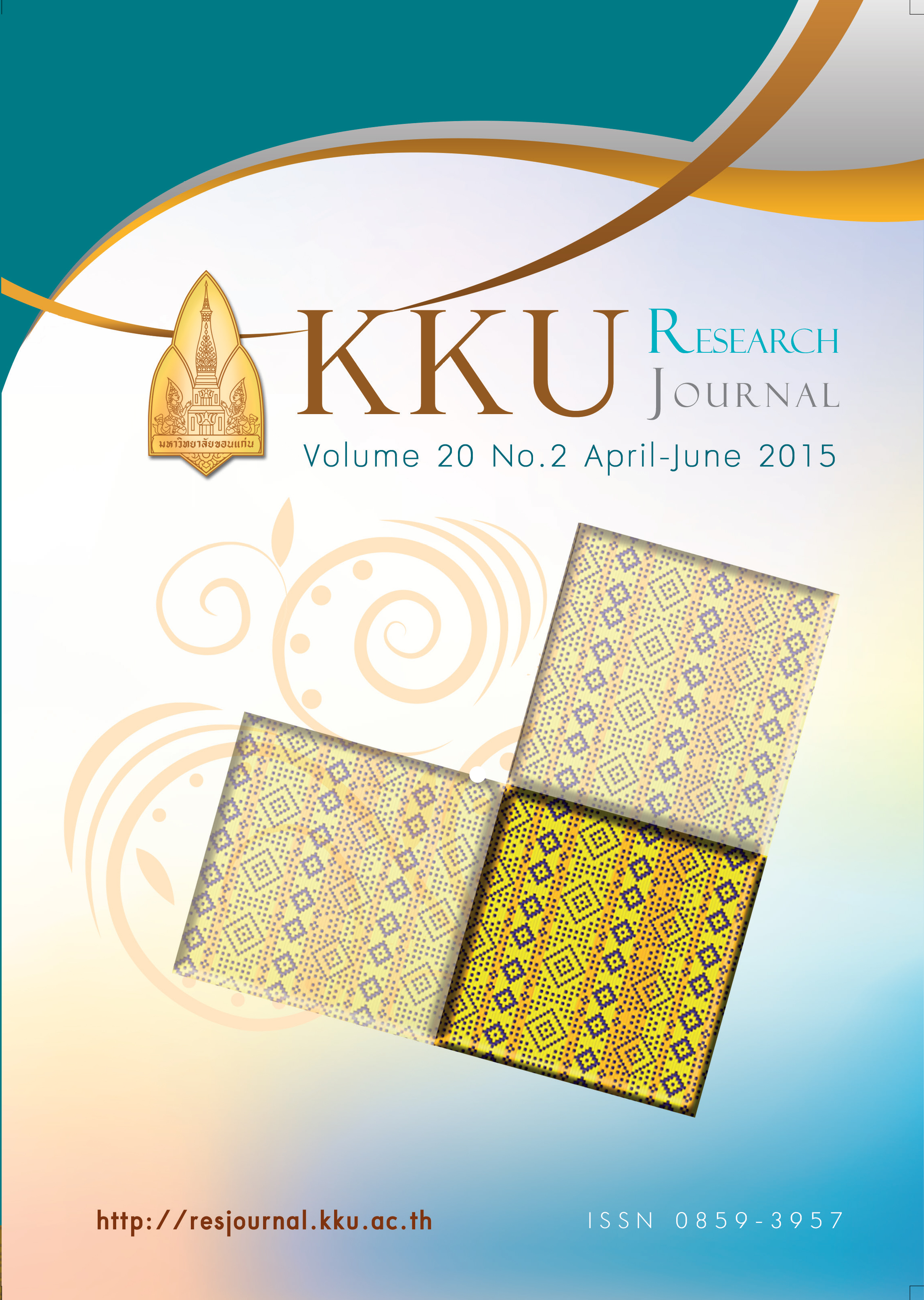Effect of temperatures on growth, yields and heat shock protein expression of Eri Silkworm (Samia ricini D.)
Main Article Content
Abstract
The effect of high temperatures on the growth, yields and heat shock protein (HSP) production of eri silkworm (Samia ricini D.) was carried out by exposure the 5th instar day 3 larvae to different temperatures, 36±1, 40±1, 42±1, 45±1 and 48±1°C for 3 hours, compared to control treatment by rearing eri silkworm continuously at normal temperature (25±2°C, 80±5%R.H.). After treated with high temperature condition, the eri silkworm larvae were reared at 25±2°C, 80±5%R.H.until cocooning, pupation, adult stage, coupling and laying eggs. The result exhibited that survival rates, cocooning rate and almost yields varied inversely to temperatures especially between 42±1 – 48±1°C. At the highest temperature, survivals and yields were the lowest, while those values were the maximum nearly all control treatments. At 48±1°C treatment, the means of all parameters were the lowest; larva survival (50.00%), survival of larva – adult (38.33%) and cocooning rate (41.67%), which were significantly different to other treatments(P<0.05). Other yields affected by 48±1°C were also the lowest; fresh cocoon weight(2.5078 g), pupa weight (2.1508 g), shell weight (0.3429 g), total cocoon shell weight(2.88 g), fresh cocoon weight/10,000 larvae (10.47 kg), egg laying/moth (287.56 eggs), hatchability (72.67%), total egg laying (1,121.33 eggs) and total hatchability (800.11 eggs). Detection of HSP of 5th instar larvae day 3 of eri silkworm treated with 5 different temperatures (36±1, 40±1, 42±1, 45±1 and 48±1 °C) was performed using sodium dodecyl sulfate polyacrylamide gel electrophoresis (SDS–PAGE), compared to control treatment (25±2°C; 80±5%R.H.). The result was clearly that the eri silkworm treated with all high temperatures expressed HSP bands of approximate 50 kDa. Whereas HSP band was not detectable in control treatment. The HSP is applicable in the thermotolerant variety improvement program of eri silkworm.
Article Details
References
[2] Sahu M, Bhuyan N, Das PK. Eri silkworm, Samia ricini (Lepidoptera: Saturniidae) Donovan, seed production during summer in Assam. Proceeding of Regional Seminar on Prospects and Problems of Sericulture as an Economic Enterprise in North West India; 2006 Nov 11-12; RSRS, Dehradune, India. 2006.
[3] Mehta TA, Greenman J, Ettelaie C, Venkatasubramaniam A, Chetter IC. McCollum PT. Heat shock proteins in vascular disease-a review. Eur J Vasc Endovasc Surg. 2005; 29: 395-402.
[4] Sreedhar AS, Soti C, Csermly P, Inhibition of HSP90: a new strategy for inhibiting protein kinases. Biochimica et biophysica Acta. 2004; 1697: 233-242.
[5] Chavadi VB, Sosalegowda AH, Boregowda MH. Impact of heat shock on heat shock proteins expression, biological and commercial traits of Bombyx mori. Insect Science. 2006;13: 243-250.
[6] Malik FA, Reddy YS. Racial features in the heat tolerance limits in the silkworm, Bombyx mori. Acta Entomologica Sinica. 2009;52(5): 478-486.
[7] Sirimungkararat S, Atthathom T, Saksirirat W. Development of eri-silkworm rearing technique using cassava leaf as food plant and its textile production. Proceedings of the XIXth Congress of the International Sericultural Commis-sion; 2002 Sep 21-25, Queen Sirikit National Convention Center, Bangkok, Thailand. 2002
[8] Howrelia JH, Patnaik BB, Selvan-ayagam M, Rajakumar S. Impact of temperature on heat shock protein expression of Bombyx mori cross-breed and effect on commercial traits. Journal of Environmental Biology. 2011;32(1): 99-103.
[9] Bradford MM. A rapid and sensitive method for the quantization of microgram quantities of protein utilizing the principle of protein- dye binding. Analytical Biochem-istry. 1976;72: 248-254.
[10] Laemmli UK. Cleavage of structur-al proteins during the assembly of the head of bacteriophage T4.Nature 1970; 227(5259): 680-685.
[11] Hussian M, Khan SA, Naeem M, Aqil T, Khursheed R, Mohsin AU. Evaluation of silkworm lines against variations in temperature and R.H. for various parameters of commercial cocoon production. Psyche 2011;(145640): 1-11.
[12] Wongsorn D, Sirimungkararat S, Mashkoa S, Saksirirat W. Impact of continuously high temperature and relative humidity in different levels on eri silkworm yields. The Conference of the Queen Sirikit Department of Sericulture, Ministry of Agriculture and Cooperatives; 2014 April 2-4, Asia Airport Hotel, Pathum Thani, Thailand. 2014. Thai.
[13] Feder ME, Hofmann GE. Heat shock protein, molecular chaperons and the stress response: evolutionary and ecological physiology. Annual Review of Physiology 1999;61: 243-282.
[14] Arrigo AP. Small heat shock proteins: chaperones that act as regulators of intracellular redox state and programmed cell death. Journal of Biological Chemistry. 1998;379: 19-26.
[15] Joy O, Gopinathan KP. Heat shock response in mulberry silkworm races with different thermotolerances. Journal of Biosciences. 1995;20(4): 499-513.
[16] Velu D, Ponnuvel KM, Qadri SMH. Expression of the heat shock protein genes in response to thermal stress in the silkworm Bombyx mori. International Journal of Industrial Entomology. 2008;16(1): 21-27.

